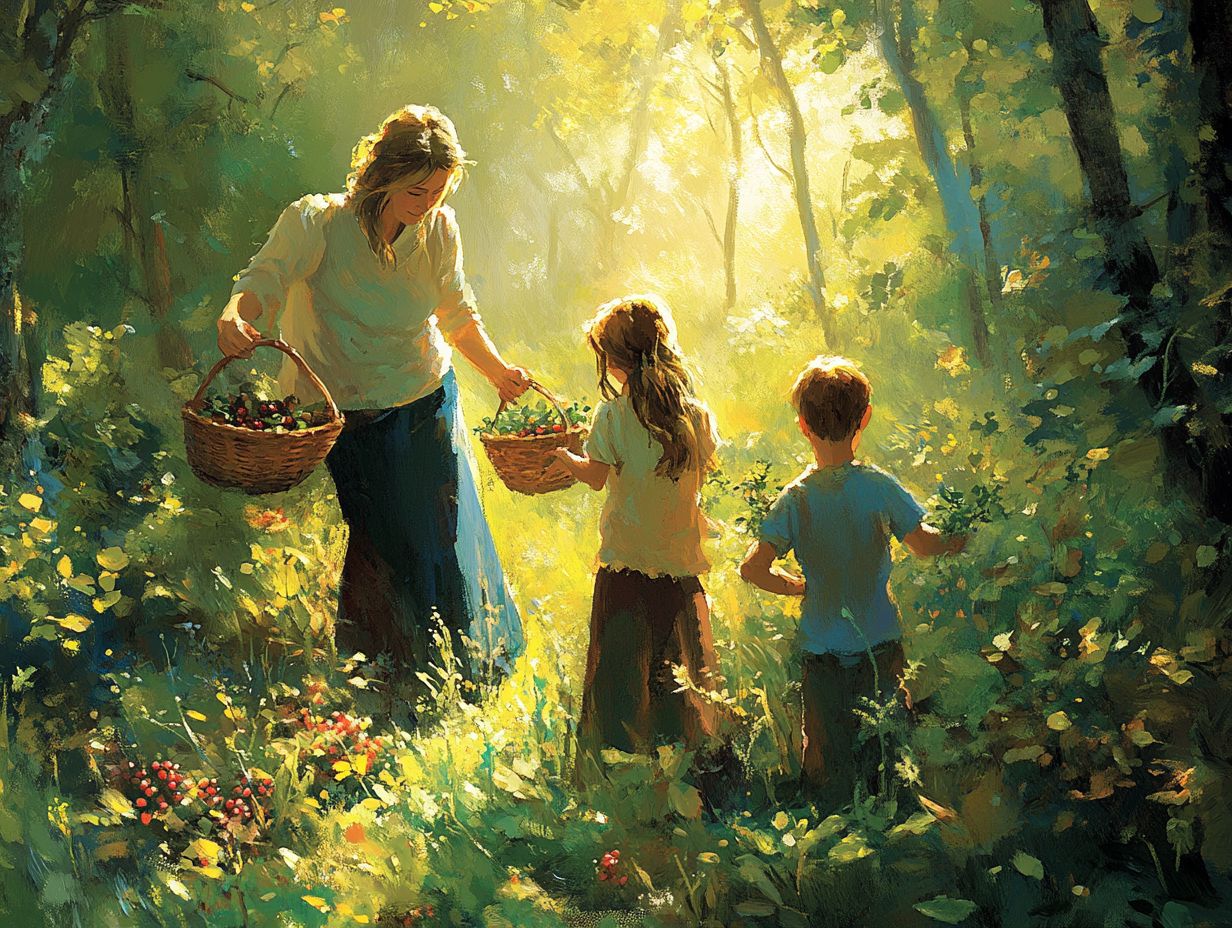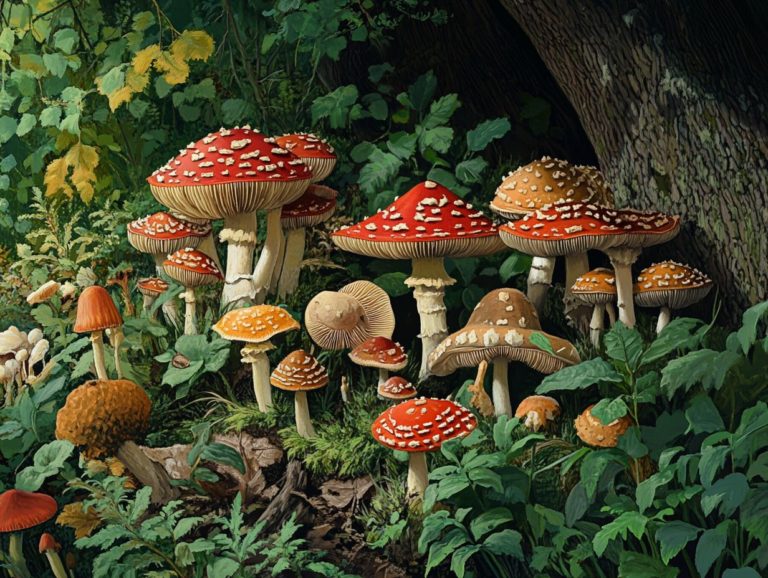How to Use Foraging as a Family Activity?
Foraging is more than gathering wild edibles. It s an exciting family adventure that strengthens your bond with nature and each other.
Consider the myriad benefits of foraging as a family. Not only does it promote physical and mental health, but it also enhances your culinary experiences with delightful recipes using your wild foods.
Get ready for your first foraging adventure with your kids! Identify safe and edible plants and fungi while practicing safety guidelines and sustainable foraging methods.
Unearth delightful recipes that will turn your foraged treasures into the centerpiece of your family table, including a refreshing purslane smoothie. Start this adventure today! Discover the joys of foraging and enhance your family life!
Contents
- Key Takeaways:
- The Benefits of Foraging as a Family
- Preparing for a Foraging Trip with Kids
- Identifying Edible Plants and Fungi
- Foraging Ethics and Sustainable Practices
- Recipes and Activities Using Foraged Foods
- Frequently Asked Questions
- What is foraging and how can it be used as a family activity?
- Where can I go for foraging with my family?
- How do I prepare for a foraging trip with my family?
- What safety precautions should I take when foraging with my family?
- What are some fun activities to do while foraging with my family?
- Can foraging be a year-round activity for my family?
Key Takeaways:

- Foraging involves searching for and collecting wild edible plants and fungi, such as dandelions and blackberries.
- Enjoy physical and mental health benefits, like improved fitness and reduced stress, by foraging as a family.
- Before heading out, pack essential foraging tools and follow safety precautions for a successful trip.
What is Foraging?
Foraging is the art of seeking out, identifying, and gathering wild edibles in their natural habitats. This practice invites you, especially if you’re with children or family, to immerse yourself in nature while exploring a variety of edible plants, herbs, and fungi that thrive nearby.
This ancient practice has evolved into a powerful tool for promoting environmental awareness and sustainable habits. By engaging in foraging, you and your family can grasp the significance of understanding local ecosystems and learning how to harvest plants responsibly.
This shared journey nurtures a child’s curiosity about biodiversity and fortifies family bonds through collaboration. As you scout for edibles together, dive into conversations about the roles of different species in their habitats and discover the beautiful interconnectedness of life.
Foraging provides a great opportunity for discussions about nutrition, food sourcing, and the joy of witnessing seasonal changes up close.
The Benefits of Foraging as a Family
Foraging as a family cultivates a healthy lifestyle and nurtures a profound sense of community and connection to the environment. Participating in this enriching activity allows you and your loved ones to enjoy various health benefits from wild edibles while also learning how to use foraging to educate others and developing a genuine appreciation for the natural world.
The shared experience of gathering edible plants fosters teamwork, deepens your understanding of nature, and offers invaluable lessons about local ecosystems and the importance of sustainable practices.
Physical and Mental Health Benefits
Foraging offers remarkable physical and mental health benefits, making it a perfect activity for families eager to enhance their well-being. Engaging with nature through foraging gets you and your children moving as you explore diverse environments and boosts mental health by cultivating a sense of peace and mindfulness.
Harvesting nutritious weeds and wild edibles encourages healthy eating habits. The skills you learn in food preservation can foster greater self-sufficiency and resourcefulness.
As you discover local foraged foods rich in vitamins and minerals think wild garlic, blueberries, and dandelion greens you’ll find both nutritional value and a direct link to the natural world. Wandering through forests and fields, foraging serves as a gentle yet effective form of exercise, promoting cardiovascular health and physical fitness.
This immersion in nature enhances your physical well-being while cultivating mindfulness, enabling you to focus on the present moment and reduce stress levels. By prioritizing nutritious foods and outdoor exploration, your family nourishes both body and mind, leading to a truly holistic approach to health and wellness.
Preparing for a Foraging Trip with Kids

Preparing for a foraging trip with your kids involves a thoughtful blend of planning and the right gear. This ensures a safe and enjoyable adventure. Before you set off, gather essential foraging tools think baskets, knives, and field guides.
Take the time to educate your children about safety guidelines. This proactive approach helps prevent any mishaps. This enriching experience teaches them the significance of responsible harvesting and fosters a deeper connection with nature and an appreciation for the wonders of wild edibles.
Essential Gear and Safety Precautions
Equipping yourself with the right gear and being mindful of safety precautions are essential for a successful foraging adventure, especially with children. Key items to have include:
- A reliable field guide for plant identification,
- Suitable foraging tools like trowels or scissors,
- Safety gear such as gloves and a first-aid kit.
By teaching children about potential hazards, you ensure that everyone can immerse themselves in the experience while minimizing the risks that come with foraging.
Bring a trusty magnifying glass. It s an engaging tool for kids to examine plant features closely. Wearing good hiking footwear and comfortable clothing enhances mobility and safety throughout the trip.
As you explore the outdoors, educate children on how to distinguish safe plants from toxic ones and recognize environmental clues, such as unusual insect activity or signs of animal presence. Incorporate interactive discussions and hands-on experiences to instill a sense of caution and wonder in young foragers.
Identifying Edible Plants and Fungi
Identifying edible plants and fungi is essential for anyone keen on foraging. It ensures safety and maximizes the rewards of wild foods. Mastering plant identification requires understanding distinguishing features, growth habits, and the ecology of local environments.
With the right knowledge, dive into the great outdoors with confidence, uncovering a wealth of edible plants, herbs, and fungi. This journey deepens your connection with nature and enriches your understanding of the natural world around you.
Common Plants and Fungi to Look For
When foraging, it’s crucial to identify which common plants and fungi can elevate your wild food experience. Consider some popular edible plants like dandelions, wild mustard, and blackberries; each offers distinct flavors and nutritional benefits.
Edible flowers can also bring vibrant colors and delightful tastes to meals, making foraging an enjoyable adventure for families eager to explore nature together.
Look for plantain, clover, and even wild ginger. These can be woven into various dishes. Young plantain leaves make an excellent addition to salads, while clover can sweeten your beverages with nature s charm.
Teach kids about the importance of correct identification, ensuring they know what is safe to eat versus what to avoid. This journey enhances the joy of discovering diverse flavors through plant walks and fosters responsibility and respect for the natural world.
As families forage together, they gather more than ingredients; they create lasting memories that enrich their culinary adventures.
Foraging Ethics and Sustainable Practices

It s important to know the ethics of foraging and how to do it sustainably. Responsible foraging means you should respect nature by only harvesting what you need, avoiding over-picking, and being mindful of the local environment.
By instilling these values in children and families during foraging adventures, you cultivate a culture of conservation and awareness that benefits both people and the planet.
Responsible Foraging and Conservation
Responsible foraging is a cornerstone of sustainable practices. It plays a vital role in conserving natural resources and biodiversity the variety of plant and animal life in a particular habitat. Educating your family about environmental awareness and how foraging impacts ecosystems is essential.
Engaging in community workshops and connecting with local foraging experts allows your children to learn the art of responsible harvesting. This nurtures a genuine appreciation for the environment.
Participating in hands-on experiences lets your family explore the rich variety of edible plants within local ecosystems. This fosters a profound sense of stewardship.
Utilizing resources like local foraging groups and informative materials will enhance this journey. You not only gather but also grasp the ecological significance of what you collect. Workshops often focus on ethical foraging practices, equipping you with sustainable methods that help preserve habitats.
Through these shared experiences, you cultivate a deeper connection to nature and contribute to a collective movement toward conservation. You inspire those around you to cherish and protect the environment.
Recipes and Activities Using Foraged Foods
Integrating foraged foods into your family meals offers a delightful opportunity to showcase nature’s flavors. This inspires your children to connect with their food sources.
Imagine crafting a refreshing purslane smoothie or experimenting with herbal recipes featuring wild edibles. The possibilities are truly endless.
By exploring creative ways to incorporate foraged ingredients, you enrich your culinary experiences. You promote valuable food preservation techniques, beneficial for families aspiring to achieve self-sufficiency.
Creative and Delicious Ways to Use Foraged Foods
Countless creative and delicious ways exist for you to utilize foraged foods. Transform a simple foraging adventure into an exhilarating culinary journey. Incorporate wild herbs into your salads and smoothies or craft jams and preserves from freshly picked berries.
Involve your children in identifying and collecting dandelion greens. These make a nutritious addition to leafy salads or can be saut ed with garlic for a delightful side dish. Edible mushrooms are another excellent option; they add a rich, earthy depth to risottos and soups.
Don t forget about making herbal teas from foraged mint or lemon balm. This can turn a cozy evening into a true sensory experience.
Encourage your family to create a foraging journal. You can keep track of new flavors and recipes you ve tried. This not only helps preserve memories but also fosters a lasting love for nature’s bounty.
Frequently Asked Questions

What is foraging and how can it be used as a family activity?
Foraging is the act of searching for wild food resources. It can be done as a family activity by exploring nature and collecting food together.
Where can I go for foraging with my family?
Head out to your favorite parks for an exciting foraging adventure! You can go foraging in parks, forests, meadows, and even in your own backyard. Just make sure to check with local regulations and laws before picking any food.
Act now to preserve the environment for future generations. Join a local foraging group today and discover the joy of nature!
How do I prepare for a foraging trip with my family?
Before heading out, research edible plants in your area. Bring a guidebook and basic tools for collecting plants, like a basket and gloves.
What safety precautions should I take when foraging with my family?
Always identify plants properly before consuming them. Avoid picking from areas that may have pesticides or are polluted. Wear protective clothing and wash your hands after handling any plants.
What are some fun activities to do while foraging with my family?
Make foraging exciting by creating a scavenger hunt for different types of plants. You can enjoy a delightful picnic with your freshly foraged finds or cook a recipe together using the ingredients you’ve collected!
Can foraging be a year-round activity for my family?
Yes! You can forage throughout the year as different plants grow in various seasons. Research which plants are safe to eat for each season to enjoy your foraging adventure!






